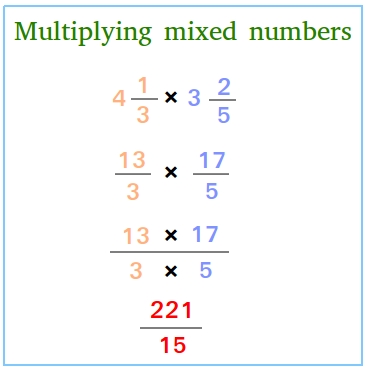Multiplying mixed numbers!
Multiplying mixed numbers is what you will learn here with some easy to follow examples.A mixed number, also called mixed fraction, is any number that has the following format:
9
3
4
The reason it is called mixed is because it is a mixture of a whole number and a proper fraction.
In our example, the whole number is 9.
The proper fraction is
3
4
Converting a mixed number into an improper fraction.
It is extremely important to convert a mixed number into an improper fraction before doing the multiplication.
Step 1. Multiply the whole number by the denominator of the fraction: (9 × 4 = 36)
Step 2. Add the result of step 1 to the numerator of the fraction: (36 + 3 = 37)
Step 3. Your numerator is the answer of step 2. Your denominator stays the same.
The fraction is
37
4
Step 4. Finally, simplify the improper fraction you found in step 3 if needed.
Now, you are ready to multiply mixed numbers with a couple of good examples.
Examples about multiplying mixed numbers

If you did not understand the examples in the figure above, just keep reading.
Example #1:
|
2
1
6
|
× 4
3
2
|
Example #1:
|
2
1
6
|
× 4
3
2
|
Rewrite each mixed number as an improper fraction by following the steps outlined above.
Here is how for 2
1
6
Step 1. Multiply the whole number by the denominator of the fraction: (2 × 6 = 12)
Step 2. Add the result of step 1 to the numerator of the fraction: (12 + 1 = 13)
Step 3. Your numerator is the answer of step 2. Your denominator stays the same.
The fraction is
13
6
and it is already in simplest form
Here is how for 4
3
2
Step 1. Multiply the whole number by the denominator of the fraction: (4 × 2 = 8)
Step 2. Add the result of step 1 to the numerator of the fraction: (8 + 3 = 11)
Step 3. Your numerator is the answer of step 2. Your denominator stays the same.
The fraction is
11
2
and it is already in simplest form
Now just multiply the fractions. Do this by multiplying the numerators together and the denominators together.
|
13
6
|
×
11
2
|
=
13 × 11
6 × 2
|
=
143
12
|
Sometimes, teachers or textbooks may ask you to write your answer as a mixed number. So feel free to rewrite 143/12 as a mixed number
|
13
6
|
×
11
2
|
=
13 × 11
6 × 2
|
=
143
12
|
Sometimes, teachers or textbooks may ask you to write your answer as a mixed number. So feel free to rewrite 143/12 as a mixed number
Example #2:
|
7
5
5
|
× 4
3
3
|
Convert the mixed numbers
|
7
5
5
|
=
7 × 5 + 5
5
|
=
40
5
|
|
4
3
3
|
=
4 × 3 + 3
3
|
=
15
3
|
|
40
5
|
×
15
3
|
=
40 × 15
5 × 3
|
=
600
15
|
and
600
15
= 40
Example #2:
|
7
5
5
|
× 4
3
3
|
Convert the mixed numbers
|
7
5
5
|
=
7 × 5 + 5
5
|
=
40
5
|
|
4
3
3
|
=
4 × 3 + 3
3
|
=
15
3
|
|
40
5
|
×
15
3
|
=
40 × 15
5 × 3
|
=
600
15
|
and
600
15
= 40
Sometimes, multiplying mixed numbers is a piece of cake with some good observations. If you had noticed that 40 divided by 5 is 8 and 15 divided by 3 is 5.
You can just multiply 8 and 5 to get 40.
Looking at the example #2 again.
Noticed that 5 divided by 5 is 1 and 3 divided by 3 is 1.
Remember that between a whole number and a fraction, there is always a + sign.
The problem just becomes 7 + 1 × 4 + 1 = 8 × 5 = 40

